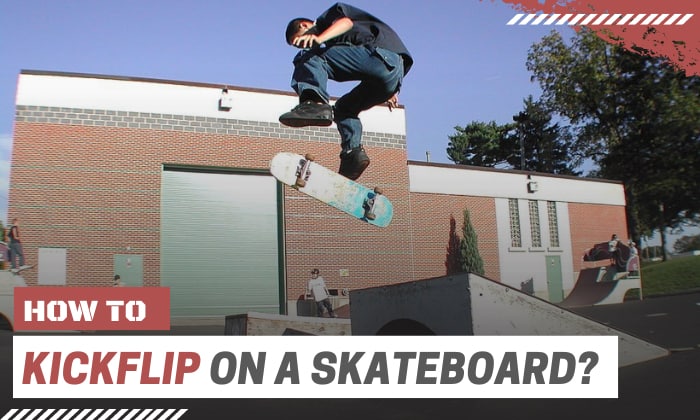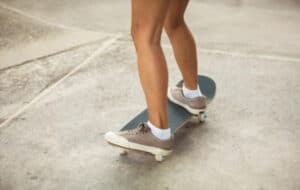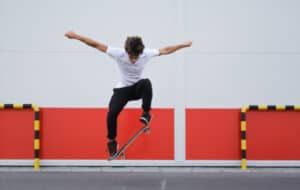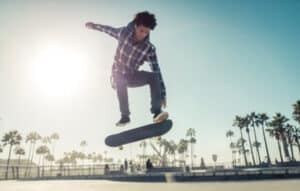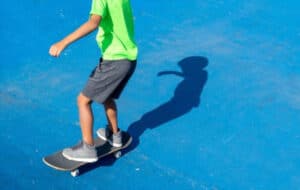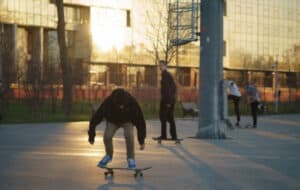Sometimes, basic jumps and ollies feel too plain that skateboarders want to try something new. Not that you should not learn these fundamental skills, but if you feel the same way, maybe it’s time to level up your skateboard tricks game.
With that, let me teach you how to kickflip on a skateboard. Here, we will learn the foundations of a seamless skateboard jump, proper foot movements, and how to be creative through a kickflip.
So, try to get through each step carefully because these will all be vital to your first successful trick execution.
Table of Contents
What You Need
The good thing about this trick is it’s not as fancy as others. We don’t need a special ramp or obstacle to do a kickflip on a skateboard. Below are the only things you should have.
- A skateboard for tricks – Of course, there is no better way to perform a trick than using a skateboard with the right features. Such a skateboard should have hard 99a wheels, a pair of sturdy trucks, and a deck size of around 7.75″ to 8.25″.
- A flat skating space – Kickflip skateboarding should be done in an open space with flat ground. It could be a parking lot or a corner at the park. Just be sure it’s free from human and vehicle traffic.
Doing a Skateboard Kickflip: Step by Step
This trick requires coordination, timing, and enough leg strength to complete the movements. Take note of the following steps to pull off this skate trick tutorial.
Step 1: Foot positioning
Let’s begin this trick with the proper posture and kickflip foot position. Whether you kickflip goofy or regular footed, it doesn’t matter as long as you perform the trick to perfection.
Place your front or dominant foot over the middle part of the deck. The shoe’s tip should point to the inner front truck bolts. Angle the heel to the side of the board by around 45°.
Next, place your back foot on the tail with the foot’s balls pressing against it. Don’t forget to bend your knees to help you balance.
Step 2: Recalling the ollie
We see ollies as a fundamental step before perfecting a kickflip.
To do this trick, you will perform two movements simultaneously. First, bend your front knee. Second, pop the skateboard’s tail using your back foot.
Remember that our goal when doing a kickflip is to give the skateboard enough height to complete its rotation. So, practice your ollies well and ensure the board gets sufficient hangtime for the final trick.
Step 3: Performing the kickflip
Kickflips in slow motion look difficult because we will have the skateboard turning in air first before landing. So, how? The flick of your front foot is a vital movement that distinguishes ollies from kickflips.
So, after popping the deck’s tail, we don’t land on the skateboard back yet. As mentioned, we should slide our front foot to the skateboard’s front edge to initiate a spin. And we should do that once the nose lifts off the ground.
How do we perfect flicking the skateboard for a kickflip? Pull your front leg off the deck to give it a spin. These motions, when done correctly, will make the deck flip mid-air.
Is a strong kick the answer to this trick? No. To learn how to do a kickflip, we still have to balance these motions to prevent the skateboard from moving erratically.
- Friendly tip: We want to give the skateboard a seamless spin. So, try to jump high to avoid blocking your board.
Step 4: Landing
Remember this rule when landing from a kickflip: back foot first.
So let’s say the skateboard is completing its rotation. The next thing to do is to have your back foot grasp the board.
Press the board down with your back foot and follow with your front. Where to step on the deck? On the front and back sets of truck bolts.
But how do we ensure that the skateboard has completed its rotation? There’s no other way to do it than by looking. Yes, it’s a bit challenging, but you will eventually learn to combine vision with timing.
Step 5: Follow-through
If falling out of balance is possible when you ride a skateboard on a regular day, what prevents the same thing from happening during tricks?
While these mishaps are inevitable, it doesn’t mean we can’t reduce them. And in the case of kickflips, here’s what to do.
First, level your shoulders while facing them in your intended direction. Second, bend your knees as both your feet contact the board.
These extra movements and positioning will not only help you balance on the skateboard. They will also help you obtain control of the deck and reduce shocks going through your legs.
Are There Other Kickflip Types?
Yes! Let’s get into some kickflip variations to expand your execution choices.
Double kickflip
This style does not differ a lot from a regular kickflip. The only difference is we allow the skateboard to turn twice. How? We flick the tip of the deck faster and with more force.
Varial
If a typical kickflip lets you have the same front foot throughout, a varial will require you to land on a different front foot.
Indy
An indy kickflip allows the skater to guide the skateboard with his hand before landing.
Underflip
Perhaps, this kickflip style is the most difficult. Here, we counter the skateboard’s first full rotation with your foot to make it spin in the opposite direction.
Frequently Asked Questions
Is a kickflip a beginner trick?
How we wish this trick was like a kickflip in Skate 3. But let’s face it. Kickflips aren’t something for beginners to master in hours. It takes a ton of timing, body coordination, and strength to perfect.
Despite these challenges, kickflips will always be doable. We only need the appropriate training and experience in the fundamentals to make learning more efficient.
Is an ollie easier than a kickflip?
Ollies are fundamental for kickflips. Does it follow that they are easier? Maybe.
As discussed, ollies do not require the skater to flick the board. We only level the skateboard on air after we pop the tail.
On the other hand, kickflips will have your skateboard spinning in air before you can level and slam it on the ground.
However, it is not easy to identify what is easier because skaters have different learning curves.
Click here to learn more steps to ollie on a skateboard and explore the 5 hardest skateboard tricks.
How to kickflip on a fingerboard?
Is a kickflip on a tech deck possible? Absolutely! Consider the following steps.
- Step 1: Put your two fingers on the deck like your primary footing on a real skateboard. Specifically, your middle finger stays at the back of the deck while the index serves as the front foot.
- Step 2: Roll the tech deck to your index finger side or forward on a regular skateboard.
- Step 3: Pop the deck’s tail to lift the nose.
- Step 4: Gently press the side of the board to twist it in the air. Note that this and the previous step are almost simultaneous movements. So, try to combine them well.
- Step 5: Find the stepping surface of the fingerboard with your two fingers and land it back down.
Can you kickflip on a longboard?
Yes! A longboard kickflip is one of the most popular tricks with longboards. The good news? It follows the same steps as kickflipping on a regular skateboard or tech deck.
Again, we only have to master the proper foot positioning, popping the board’s tail, flicking the deck, and landing balanced.
Can you kickflip on a scooter?
It’s possible to kickflip scooter, but the move won’t be the same as the one you do on skateboards. After all, scooters have handlebars and a stem.
Conclusion
In skateboarding, it all starts with fundamental skills. And in the case of kickflips, everything is built upon an ollie.
So, now that you know how to kickflip on a skateboard, you can pull off this move instead of watching someone doing a kickflip in the park. Remember to aim for a perfect flick to initiate a decent skateboard rotation.
Keep practicing, and you will be ready for more tricks.

Hi, I am Charles Harris. I opened this site to write as much as I can about my biggest passion – skateboarding!
I started as a clumsy yet passionate rookie 10 years ago to now a still passionate yet much better skateboarder! But I have to tell you, the whole journey has always been fun and rewarding, indeed not without hardship.


